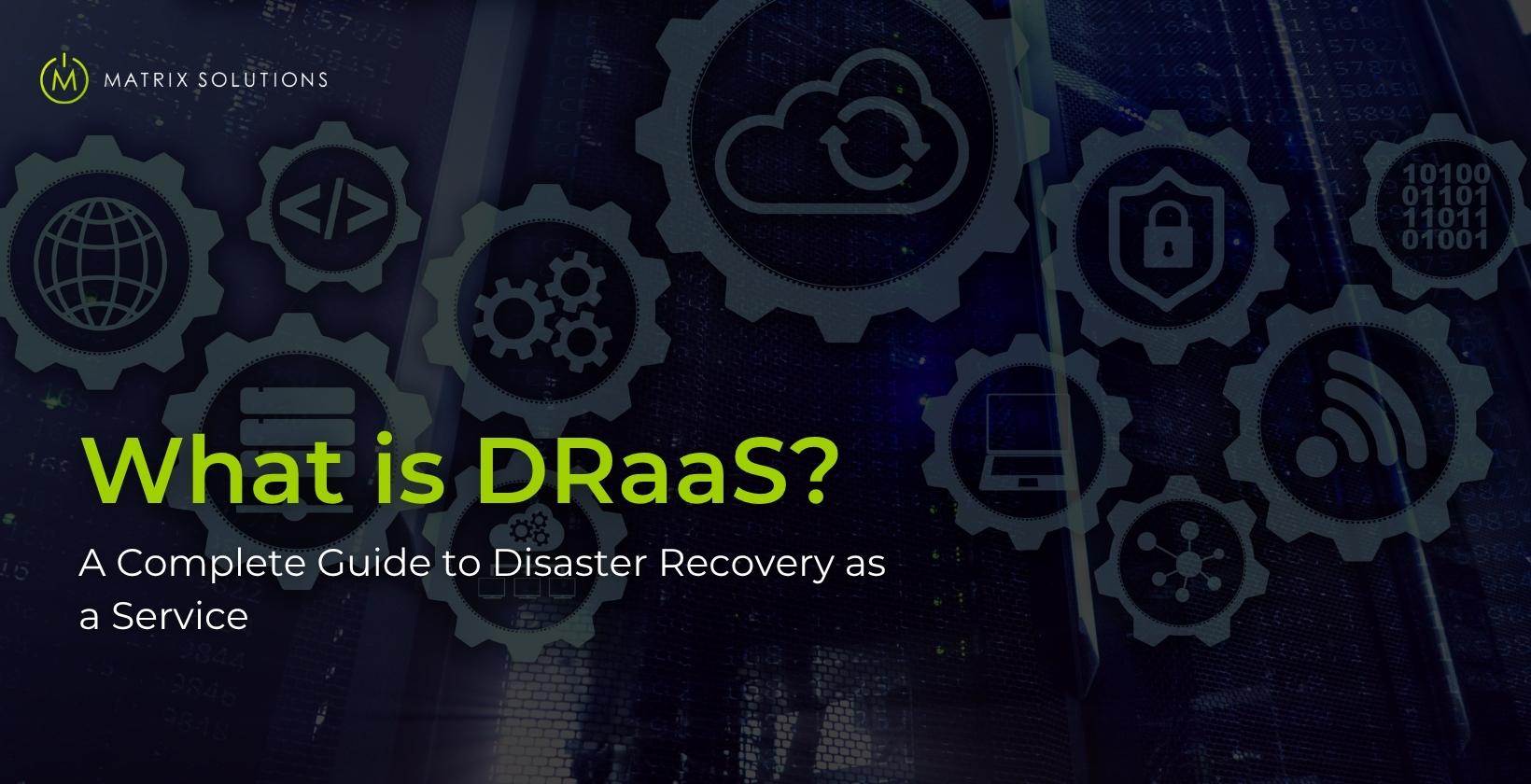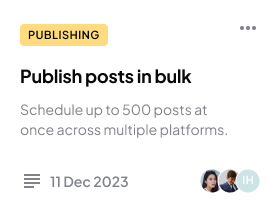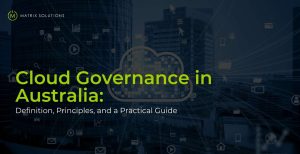Downtime hurts. Even short outages for law firms, finance teams, and insurers can breach contracts, trigger penalties, or erode client trust. Yet over half of Australian SMEs still depend on manual backups and untested recovery plans.
Disaster Recovery as a Service (DRaaS) changes that. It keeps your systems online with cloud-based failover, tested recovery points, and no on-site infrastructure dependency. You are covered against ransomware, hardware failure, or disaster, without the complexity of running it all yourself.
At Matrix Solutions, we deliver managed DRaaS tailored to Australian compliance, industry risk, and business continuity standards. It’s recovery that works when it matters most: fast, secure, and fully aligned with local needs.
What Is DRaaS in Cloud Computing?
Disaster Recovery as a Service (DRaaS) is a cloud-delivered solution that keeps your business operational when core systems fail. It mirrors your production environment to a secure cloud platform, allowing you to restore access quickly after an outage, without relying on physical infrastructure.
When disruption hits, DRaaS initiates an automated failover, restoring access to your workloads in the cloud without needing physical infrastructure.
What sets cloud DRaaS apart from traditional recovery models:
- Your provider fully manages it; no internal resources needed.
- Failover and failback are automated and pre-orchestrated.
- It integrates with on-prem, hybrid, or cloud-native systems.
- Recovery times and data loss windows are clearly defined in your SLA.
- It scales without hardware investment or secondary data centres.
This makes DRaaS ideal for Australian SMEs needing reliable recovery, low overhead, and compliance alignment, without the manual burden of maintaining redundant systems.
What Are RPO and RTO in Disaster Recovery?
Recovery Point Objective (RPO) and Recovery Time Objective (RTO) define how a disaster recovery plan performs under pressure. These metrics shape how much data you can afford to lose and how quickly systems need to be restored.
Every DRaaS solution is built around these two benchmarks.
They directly influence:
- The frequency of data replication
- How failover is triggered and managed
- What kind of SLAs does your provider commit to
- How your business balances cost, risk, and compliance
Recovery Point Objective (RPO): How Much Data Loss Is Acceptable?
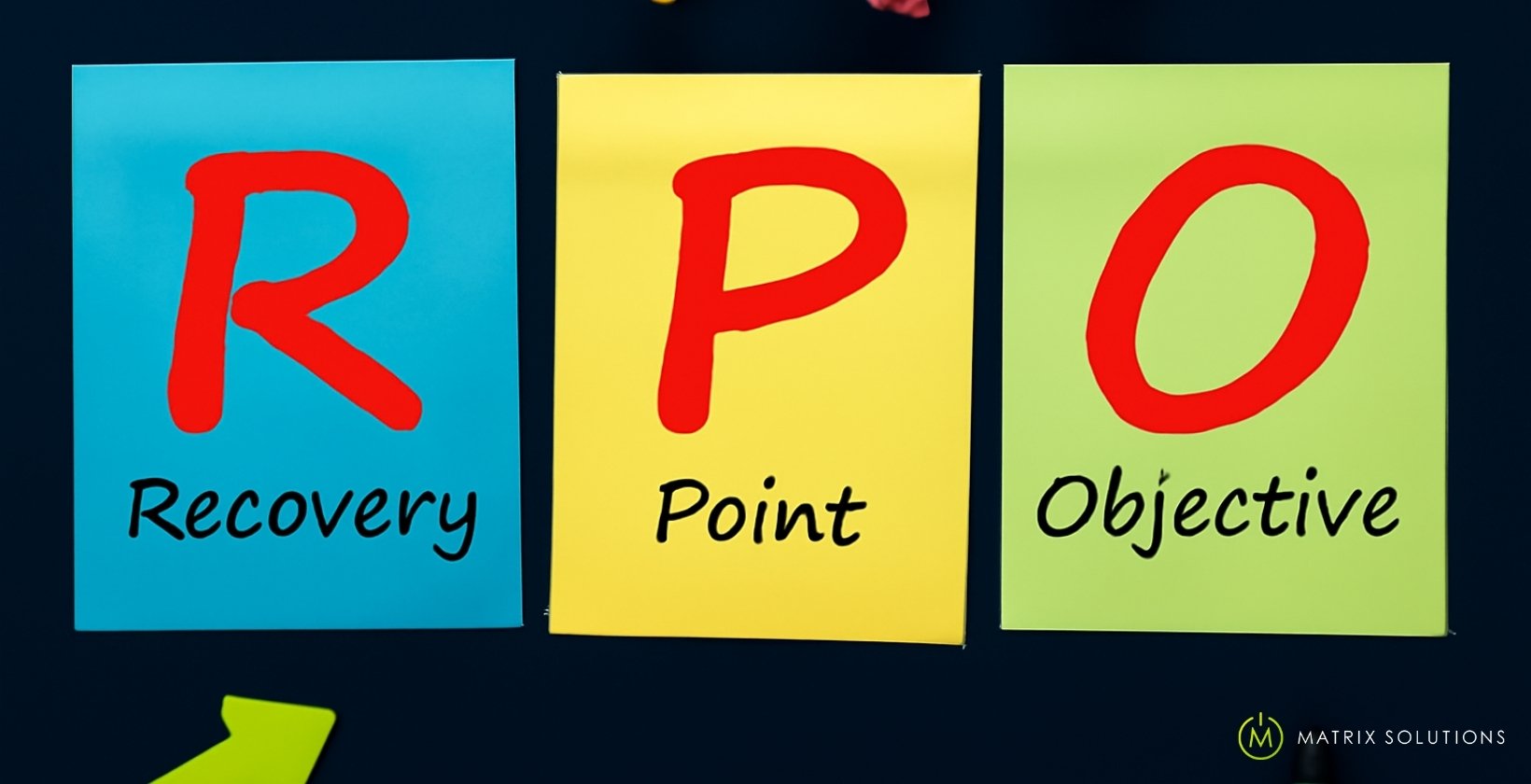
RPO (Recovery Point Objective) defines how much recent data your business can afford to lose in a disruption. It determines how often backups or replications must occur.
For example, if your RPO is four hours, your system must never lose more than four hours’ worth of data. That means backups or replication need to happen at least every four hours.
RPO is especially critical in sectors where data accuracy and transaction logging are non-negotiable, like legal, finance, or insurance.
What affects your RPO target:
- Data sensitivity and business impact of loss
- Regulatory obligations (e.g., financial recordkeeping)
- System workload and change frequency
- Available bandwidth for replication
Recovery Time Objective (RTO): How Quickly Should You Restore Operations?
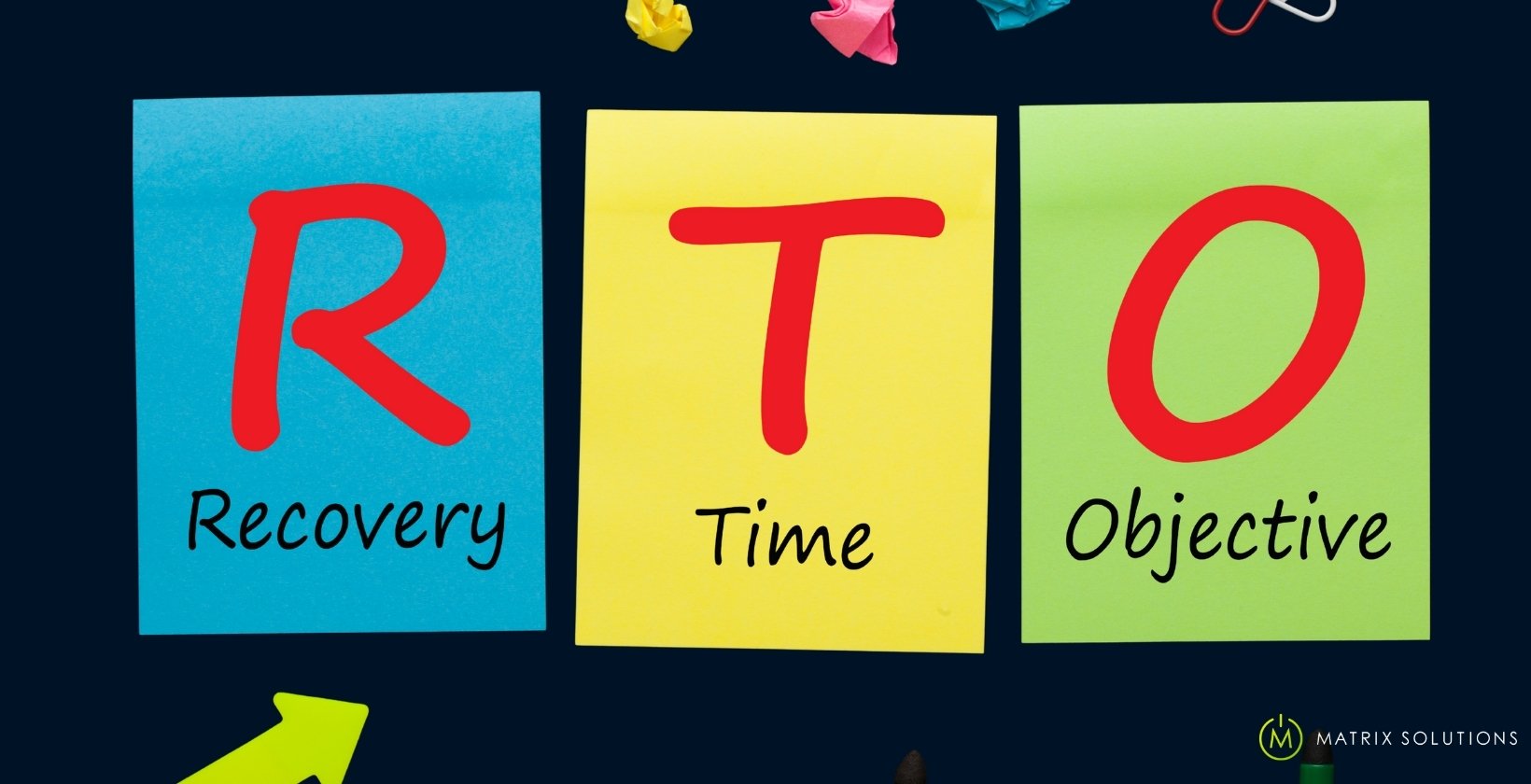
RTO (Recovery Time Objective) defines how fast your systems need to be restored after a failure. It’s the maximum time your business can remain offline before operations are severely impacted.
For example, if your RTO is two hours and a server fails at 10 a.m., your DRaaS provider must have your systems fully restored and operational by 12 p.m.
RTO often drives the choice between full DRaaS and basic backup solutions. The shorter the RTO, the more robust and automated the recovery process needs to be.
RTO is shaped by:
- Customer expectations and service delivery commitments
- Internal SLAs between teams and departments
- Legal or contractual uptime requirements
- Productivity and operational cost of downtime
While you are at it, learn about the Basics Of an IT Disaster Recovery Plan.
How Does DRaaS Work Step-by-Step?
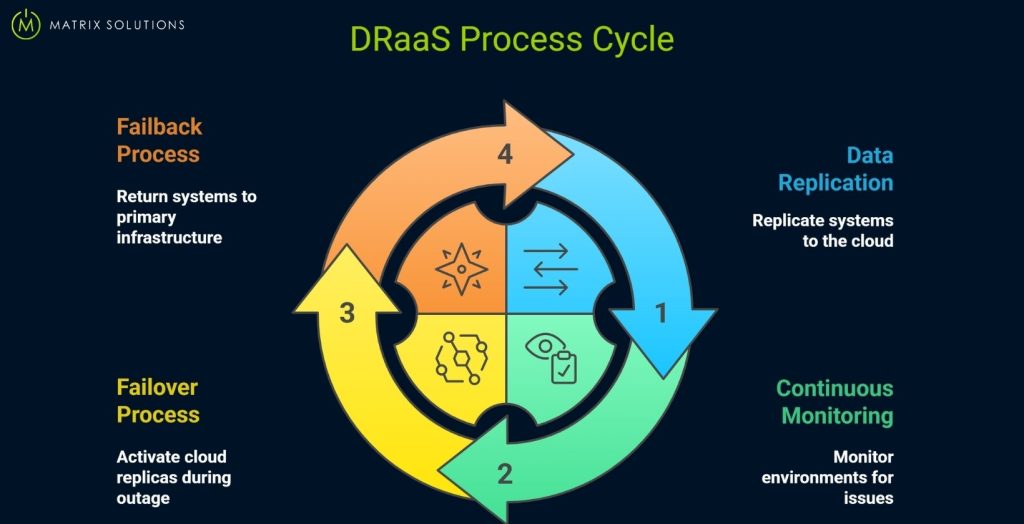
Disaster Recovery as a Service works by maintaining a live, off-site version of your systems, ready to take over in the event of a production environment failure. It’s full system replication, tested failover, and seamless return to normal operations, rather than just a normal data backup.
Each step outlined below plays a critical role in protecting business continuity, ensuring compliance, and reducing the burden on in-house IT teams.
Step 1: Data Replication to the Cloud
The process begins by replicating your production systems: servers, databases, and applications, to a secure cloud environment. This replication can be real-time or scheduled, depending on your RPO targets.
When configured properly, replication ensures:
- Your recovery environment stays in sync with live operations
- Data loss is limited to the pre-defined RPO window
No manual intervention is needed when a failover is triggered
This step is foundational. Without it, failover has nothing reliable to fall back on.
Step 2: Continuous Monitoring & Health Checks
Once replication is in place, the DRaaS platform actively monitors both environments to ensure continuous operation. Health checks detect issues like:
- Replication lags
- Configuration drift
- Network bottlenecks
- Resource exhaustion
Monitoring keeps your recovery site “hot” and ensures that when you need to switch, it works. It also aligns with most audit and compliance requirements, particularly in industries where failure to comply can result in penalties.
Step 3: Failover Process During Outage
When a disruption occurs, whether from a cyberattack, hardware failure, or human error, failover kicks in. Your DRaaS solution automatically brings cloud replicas online, redirecting services to them.
Failover generally:
- Minimises downtime
- Preserves user access
- Meets your defined RTO window
- Requires no hands-on involvement during crisis response
This stage ensures continuity during peak operational pressure, when timing, trust, and response matter most.
Step 4: Failback After System Recovery
Once the primary environment is stable, DRaaS enables failback. This step returns systems and data from the cloud back to your local or preferred infrastructure.
Failback includes:
- Synchronising changes made in the cloud during failover
- Gracefully transferring workloads with no data loss
- Validating performance before switching traffic back
This completes the recovery loop, ensuring you don’t just survive the outage, but return to a normal environment, cleanly and securely.
How Do You Choose the Right DRaaS Provider?
If your firm relies on uptime, compliance, or client data integrity, your DRaaS provider needs to match more than just budget. It should align with your systems, recovery targets, and industry-specific obligations, particularly in the legal, financial, or insurance sectors.
Use the following criteria to assess whether a provider can deliver the recovery performance your business expects.
Fully-Managed vs. Self-Service DRaaS Models
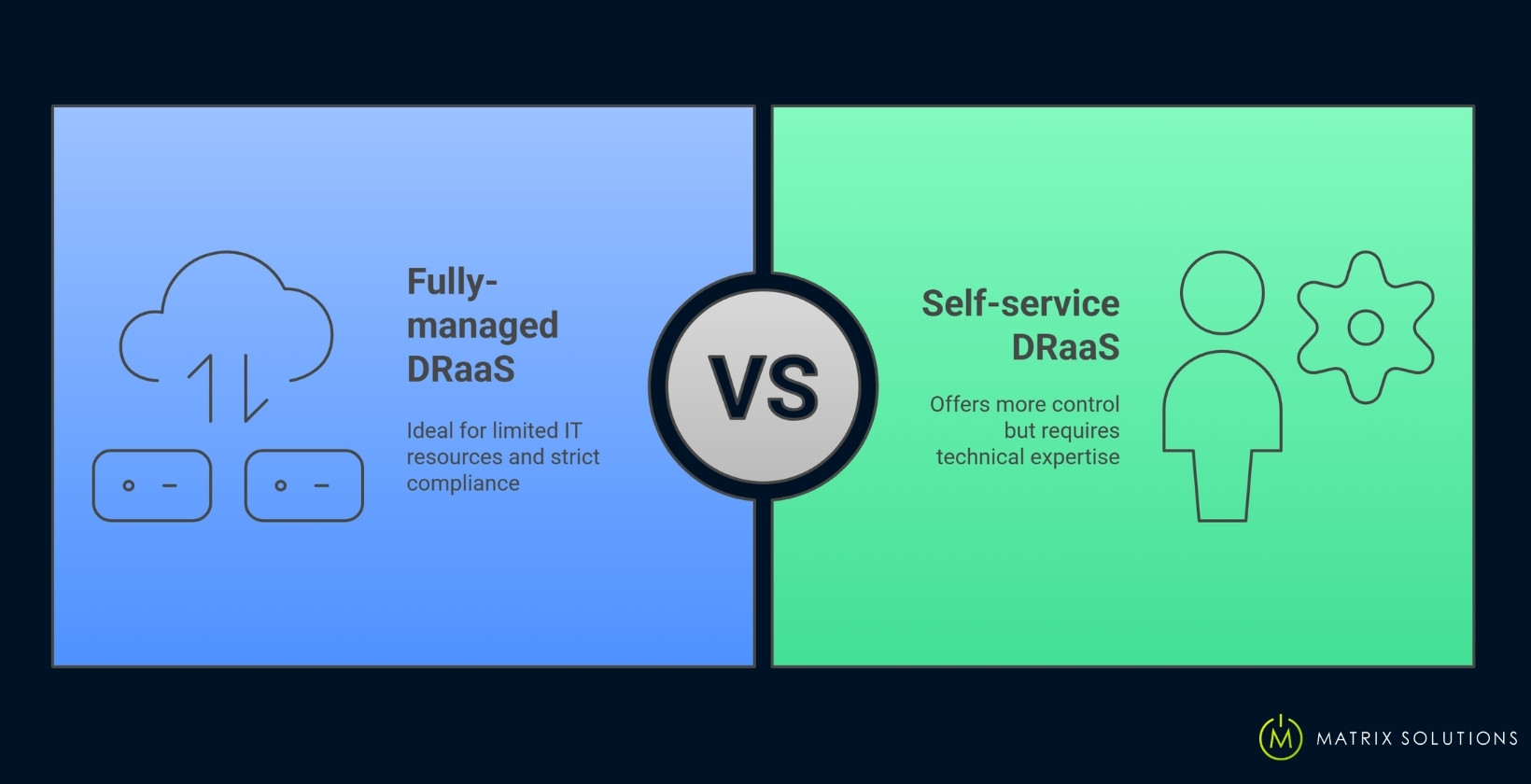
Start by confirming the service model. Most providers offer one of two options:
Fully-managed DRaaS: Managed Disaster Recovery Service provider takes care of configuration, replication, monitoring, failover, and failback. This model suits firms with limited in-house IT resources or strict compliance requirements, where downtime must be avoided without requiring internal intervention.
Self-service DRaaS: You manage the setup, testing, and response processes. This gives more control but requires technical capability, especially during high-stress recovery events.
For Australian SMEs, a managed approach often provides better assurance, especially when RTOs are tight or systems are mission-critical.
Cloud, On-Prem, or Hybrid Environments
Your infrastructure determines which providers are compatible with it.
- If you run cloud-native systems, you’ll need a DRaaS solution that integrates with your cloud provider (e.g., AWS, Azure, VMware Cloud).
- If you rely on on-prem servers, ensure the provider supports physical and virtual machine replication.
- If your setup is hybrid, look for flexibility that supports both cloud and on-premises failover without requiring re-architecting of workloads.
The right fit is one that aligns with your current architecture while supporting future transitions.
Security, Encryption, and Data Sovereignty Compliance
Security is non-negotiable. Your provider should demonstrate:
- End-to-end encryption for data in transit and at rest
- Role-based access controls with audit logging
- Independent certifications like ISO 27001 or SOC 2
- Australian data sovereignty, ensuring your data is stored within local jurisdictions
If you work in law, finance, or insurance, verify alignment with frameworks such as APRA CPS 234 or the Australian Privacy Act. Anything less creates compliance risks.
Testing, SLAs, and Ongoing Technical Support
A DRaaS solution is only as strong as its response under pressure. Look for:
- Non-disruptive testing capabilities so you can validate recovery without halting operations
- Clear SLAs outlining maximum RTO and RPO commitments
- 24/7 local support with escalation paths, not offshore call centres
- Proactive monitoring to alert you before issues become outages
Ask potential providers how often they test failover, and whether their RTO claims are theoretical or field-tested.
What Is the Difference Between DRaaS and BaaS?
Disaster Recovery as a Service (DRaaS) and Backup as a Service (BaaS) both protect data, but they serve very different purposes.
If your goal is to achieve full system recovery with minimal downtime, DRaaS is the ideal solution. If you only need to retain files for legal or regulatory reasons, BaaS may be sufficient. Here’s how they compare:
| Feature | DRaaS (Disaster Recovery as a Service) | BaaS (Backup as a Service) |
|---|---|---|
| Purpose | Restore full systems fast after disruption | Retain and restore files or data |
| What it protects | Applications, servers, configs, databases | Files, folders, and databases only |
| Failover capability | Yes, systems shift to the cloud automatically | No, manual recovery only |
| Recovery time (RTO) | Minutes to hours | Hours to days |
| Use case | Business continuity and uptime | Data retention, compliance, archiving |
| Complexity | Higher; involves orchestration and testing | Lower; simpler to manage |
| Cost | Higher; but offsets downtime risk | Lower; focused on storage only |
Why Do Businesses Use DRaaS?
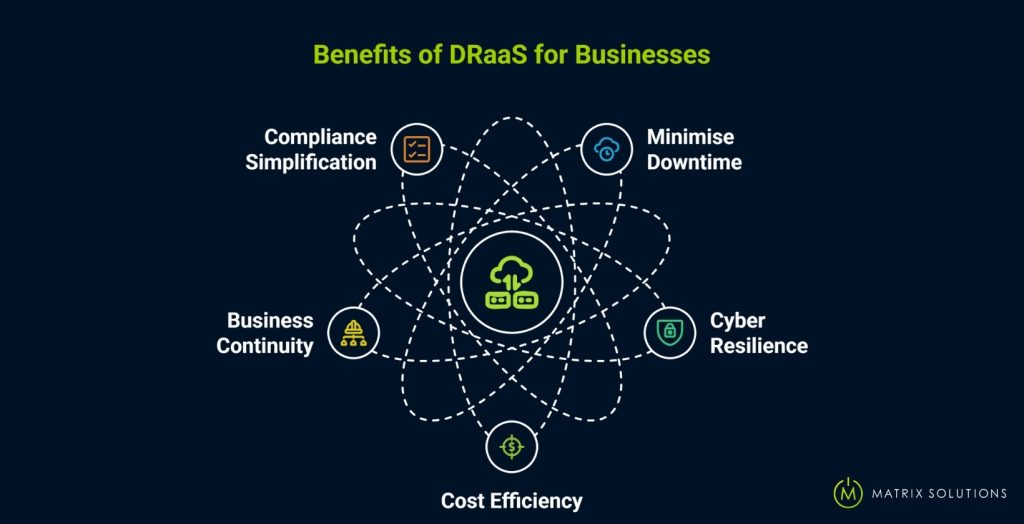
Ask any IT lead or operations manager what keeps them up at night. It’s the fear that a single system failure could bring the entire business to a halt. And the truth is, it happens more often than most firms are ready for.
That’s where DRaaS earns its place, not as a backup plan, but as a core part of staying operational, profitable, and audit-ready. Here’s how it delivers where it counts:
Minimise Downtime and Protect Revenue
Every business relies on uptime, whether it’s case files, payment systems, or client portals.
Recovery is initiated without requiring any manual intervention with DRaaS. If something fails, your systems switch over to the cloud, and your team keeps working. No panic, no drawn-out rebuilds, and no lost revenue while waiting for IT to catch up.
Achieve Cyber Resilience Against Ransomware
We have seen too many businesses get locked out of their systems by ransomware, and some never even recover properly. DRaaS provides a clean, off-site version of your environment, ready to go. Even if your network is compromised, your recovery point remains untouched. You restore, move on, and avoid the drama of ransom payments or weeks of downtime.
Shift from Capital Expense (CapEx) to Operating Expense (OpEx)
Building out your recovery infrastructure is expensive, and most of it just sits idle, waiting for something to break.
With DRaaS, you pay a flat monthly cost as a flexible operating expenditure (OpEx), only for the resources you use. There’s no need to buy hardware, maintain second sites, or over-engineer for rare events, incurring large upfront capital expenditures (CapEx). It’s simple, scalable, and far easier to justify when budgets are tight.
Ensure Business Continuity and Customer Trust
In today’s economy, the longer your systems are down, the harder it is to maintain client trust and a strong brand reputation. DRaaS helps you avoid that scenario entirely. Even during major outages, your business stays responsive. You hit your service targets, you stay reliable, and your clients don’t even notice there was an issue behind the scenes.
Simplify Compliance and Audits
When auditors ask for proof of your recovery plan, vague answers won’t suffice. DRaaS simplifies this by providing you with logs, policies, and backup snapshots that are ready when needed. It helps you tick the boxes for ISO 27001, APRA CPS 234, and Privacy Act compliance, without scrambling every time someone requests evidence.
DRaaS Frequently Asked Questions (FAQ)
How often should you test a DRaaS plan?
To test a DRaaS plan effectively, most experts recommend doing DR tests at least twice a year. Testing your DRaaS plan ensures recovery works as expected and remains aligned with your current systems and compliance requirements.
What is the difference between failover and failback?
The primary difference between failover and failback lies in direction: failover moves systems to your backup environment during a failure, while failback returns everything to your primary setup after recovery. Both processes are integral components of a comprehensive DRaaS plan.
How much does DRaaS cost?
DRaaS costs vary based on recovery time objectives (RTO), data volume, provider, and service model. Most DRaaS pricing models utilise a monthly subscription, making it more cost-effective than building a disaster recovery environment from scratch.
Can DRaaS support hybrid IT environments?
Yes, DRaaS can support hybrid IT environments. A hybrid DRaaS solution protects both on-prem systems and cloud platforms by replicating workloads across both, ensuring consistent data recovery and continuity in mixed infrastructure environments.
Is DRaaS suitable for small businesses?
Yes, DRaaS is suitable for small businesses. It offers enterprise-grade recovery at a manageable cost, eliminating the need for in-house infrastructure, making it ideal for SMEs that require reliable business continuity without investing in a full-scale disaster recovery system.
Does DRaaS help with ISO audits?
Yes, DRaaS helps with ISO audits by providing structured logs, recovery testing evidence, and control documentation. These artefacts support compliance with ISO 27001 by demonstrating business continuity measures and secure data handling.
What DRaaS SLAs should legal teams demand?
Legal teams should demand SLAs with clearly defined RTO/RPO, data sovereignty assurance, 24/7 local support, and non-disruptive recovery testing. These ensure DRaaS supports legal compliance, client obligations, and rapid dispute resolution.
Why Choose Matrix Solutions for DRaaS?
When systems go down, you don’t want a vendor; you want a team that already knows your environment, your risk profile, and how to bring you back online without missing a beat.
That’s what we do at Matrix Solutions.
We’ve spent over a decade working with Australian law firms, finance teams, and insurers, helping them recover quickly, stay compliant, and get back to business.
Here’s what makes us a safe pair of hands:
- Certified Security & Compliance: We adhere to ISO 27001 and SOC 2 standards, and we maintain your data onshore, with no shortcuts when it comes to sovereignty or regulation.
- Local 24/7 Support: When you call for help, you’re speaking with someone who knows your system, not a call centre reading off a script.
- Fits Your Infrastructure: We support cloud, on-prem, or hybrid environments without forcing platform changes. If it works for you, it works for us.
- Trusted by Legal Firms Nationwide: We’ve supported critical case management systems, court compliance workflows, and client data protection for over ten years, and we know how much is at stake.
If you are looking for a DRaaS partner that understands Australian business, risk, and regulations, we are ready when you are. Contact us now and talk to a DRaaS expert!


